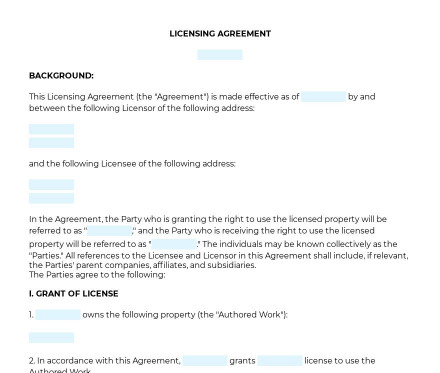Licensing Agreement Free
When the owner of a particular type of intellectual property (logo, photo, etc.) wants to grant permission to another person to use their property, this Licensing Agreement may be used.


 Template Overview
Template Overview
When the owner of a particular type of intellectual property (logo, photo, etc.) wants to grant permission to another person to use their property, this Licensing Agreement may be used. In the agreement, two parties are involved. The first one is the party owning the property (the "Licensor), and the other one is the party using the Licensor's property (the "Licensee). In the document, they specify how the license will be granted. Usually, the Licensor who is giving the rights to someone to use their intellectual property gets compensation. This agreement differs from the Intellectual Property Release, as it does not transfer the ownership of the property.
With this agreement, the Licensor can make money and remain the owner of their intellectual property.
You fill out a form. The document is created before your eyes as you respond to the questions.
At the end, you receive it in Word and PDF formats. You can modify it and reuse it.
 How to use this template
How to use this template
When an individual wants to get the rights to use someone's intellectual property, he can use this document. Also, the document can be used by someone owning the property and wishing to grant permission for usage. In the document, the parties can outline the specifics of that usage, as well as terms and distribution.
 Applicable law
Applicable law
No laws govern Licensing Agreements. In the US, intellectual property is covered under primarily federal law, with the main statute applicable being the Copyright Act of 1976. We recommend adding as much information as possible.
Ready to build your document from this template?



 Please wait
Please wait